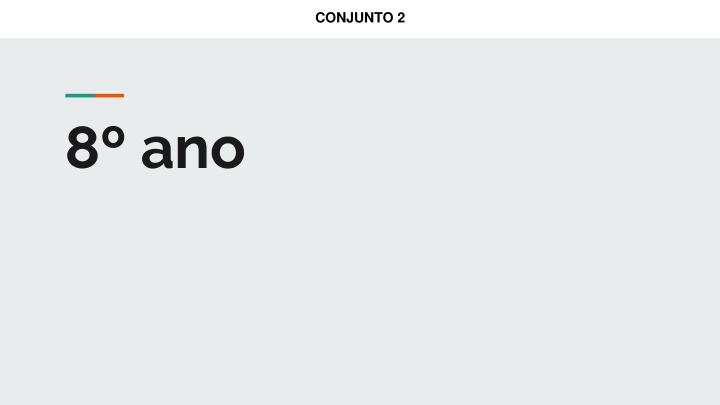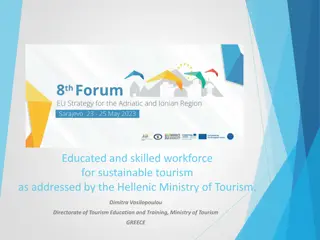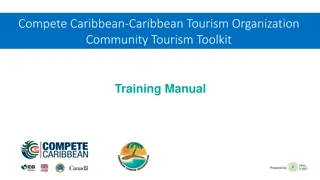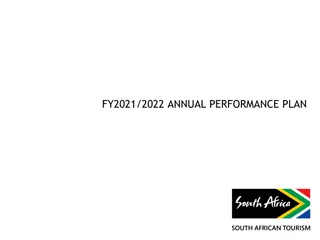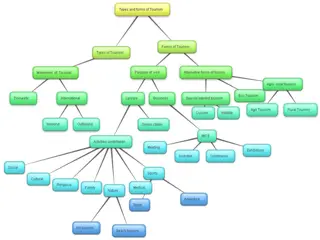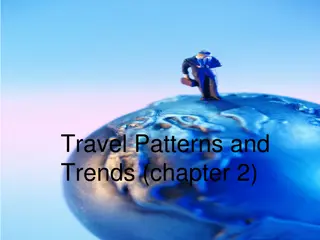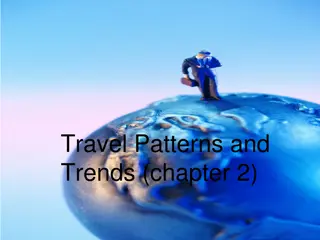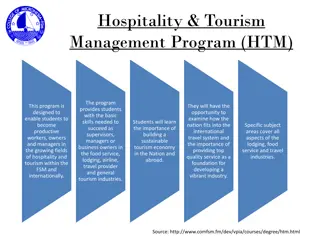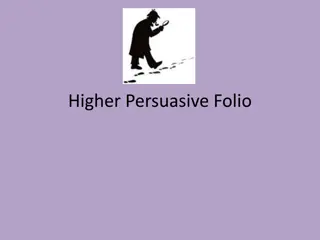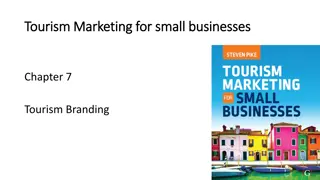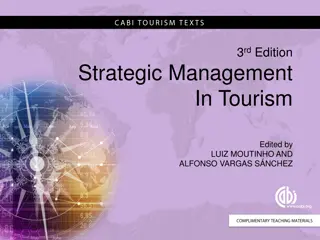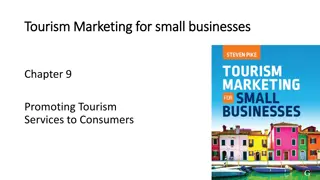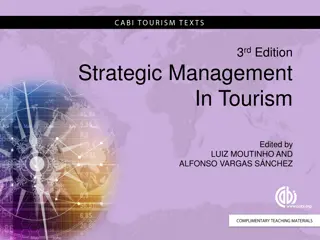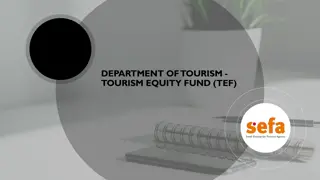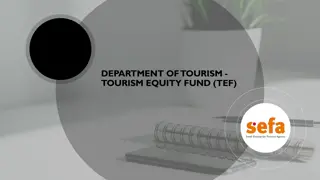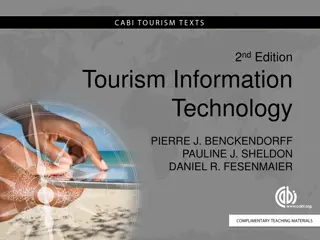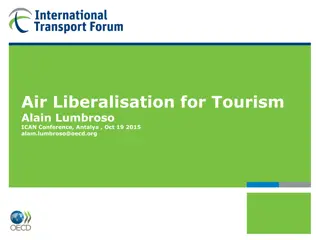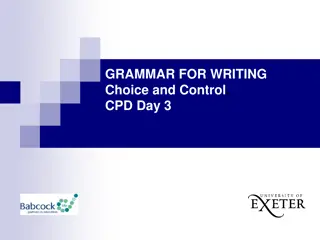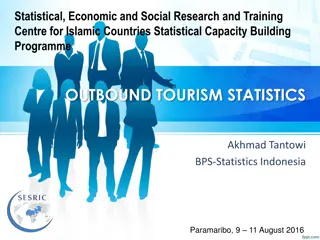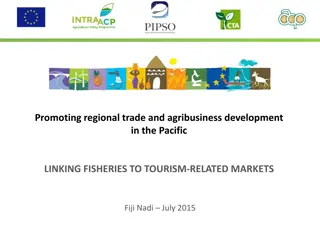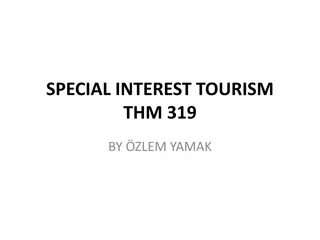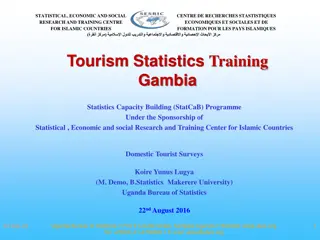Using Descriptive and Persuasive Language in Tourism Promotion
Create compelling content to entice potential travelers and educate on sustainable tourism practices. Understand the structure and themes for tour package programs and educational videos about sustainable tourism. Explore the social functions and target audiences for each type of content, along with insights into who produces them.
Download Presentation

Please find below an Image/Link to download the presentation.
The content on the website is provided AS IS for your information and personal use only. It may not be sold, licensed, or shared on other websites without obtaining consent from the author.If you encounter any issues during the download, it is possible that the publisher has removed the file from their server.
You are allowed to download the files provided on this website for personal or commercial use, subject to the condition that they are used lawfully. All files are the property of their respective owners.
The content on the website is provided AS IS for your information and personal use only. It may not be sold, licensed, or shared on other websites without obtaining consent from the author.
E N D
Presentation Transcript
CONJUNTO 2 8 ano
Unit 3 Online Tour Package Program Descriptive and persuasive language to promote a tour package program. Typically, it includes a title, an introduction, a list of destinations, details about accommodation, transportation, activities, and meals, a price list, and a call-to-action. Recurrent structure Travel, tourism, leisure, adventure, cultural experiences, accommodation, transportation, foods and drinks, sightseeing, and entertainment. Main themes
To promote a tour package program and persuade potential customers to book and participate in a trip or vacation. It aims to highlight the main attractions, experiences, and benefits of the package, and provide all necessary information to enable a customer to make an informed decision. Social function People interested in traveling and experiencing new cultures and destinations. They may search for tour packages online or receive recommendations from friends, family, or travel agencies. Target audience Tour operators, travel agencies, hotels, and other tourism-related businesses that offer tour packages. They may hire professional copywriters or marketing specialists to write and design the online tour package program. Who produces it?
Unit 3 Educational Video about Sustainable Tourism Typically, they may follow a structured format, such as an introduction to the topic, followed by an explanation of the impacts of unsustainable tourism, and then providing examples. They may also include interviews with experts or case studies. Recurrent structure The importance of preserving natural and cultural resources, reducing environmental impacts, supporting local communities, and promoting responsible travel behavior. The video may also address topics such as ecotourism, sustainable accommodations, etc. Main themes
To raise awareness about the importance of sustainable tourism practices and to promote responsible travel behavior. It aims to educate and inform viewers about the impacts of tourism on the environment, local communities, and cultural heritage. Social function Anyone who is interested in learning about sustainable tourism practices, including travelers, tourism professionals, students, etc. Target audience It may be produced by a variety of organizations, such as government agencies, non-profit organizations, tourism boards, and travel companies. They may also be produced by independent filmmakers. Who produces it?
Unit 3 Be Going To Going to, assim como will, usado para nos referirmos ao futuro. Forma afirmativa: sujeito + to be no simple present (am, is, are) + going to + verbo principal no infinitivo sem to. I m going to help my uncle in the orchard. Forma negativa: sujeito + to be no simple present (am, is, are) + not + going to + verbo principal no infinitivo sem to. I m not (isn t) going to hike with my cousin this time.
Forma interrogativa: to be no simple present + sujeito + going to + verbo principal no infinitivo sem to. Are you going to hike this weekend? Respostas curtas afirmativa e negativa Are you going to visit your uncle? Yes, I am. / No, I m not.
Will vs. Going To Usamos will ou going to para falarmos de eventos futuros ou previs es. It s going to / ll be awesome! (previs o) Em geral, will mais formal que going to. Usamos going to em vez de will para falarmos de planos ou decis es para o futuro. We re going to eat at a local restaurant. (plano)
Usamos will para falar de certezas no futuro. My birthday will be next weekend. (certeza) Usamos going to para falar de uma previs o quando baseada em algo externo, que percebemos, por exemplo, no momento em que falamos. Today it s going to rain. There are so many clouds in the sky. (Observando as nuvens, percebemos que ir chover).
Advrbios de frequncia Always 100% Usually 80-90% Often 70-80% Sometimes 50% Rarely 20-30% Hardly ever 10-20% Never 0%
